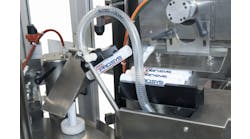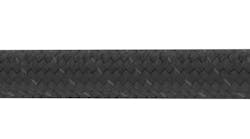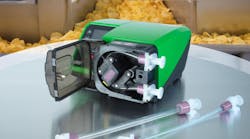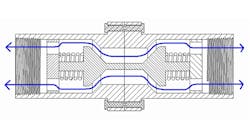Latest from Learning Center
Predictive Maintenance Learning Center
Top Manufacturing Stories of 2024
Best Manufacturing Guides of 2024
What Is an Industrial PC?
Download this article in PDF format.
It can be challenging to make sure you’ve covered all the bases during the plastic tubing and hose selection process. Have you considered all the elements involved with the application?
Temperatures, chemicals, pressures, flexibility needs? Have you ever ordered hundreds, even thousands, of feet of plastic tubing or reinforced hose and then found it wasn’t the best product for your application?
The Top 20 Tubing & Hose Buying Tips were developed by NewAge Industries to help avoid the downtime, costs, and frustration involved with ordering the wrong tubing or hose.
The tips highlight details that can be overlooked, present questions to ask your supplier, and suggest research you can do to help avoid buying errors.
1. Check for Ingredient Approvals
You may need to know if the tubing or hose under consideration is manufactured with FDA (Food and Drug Administration), NSF (National Sanitation Foundation), USP Class VI (United States Pharmacopoeia), 3-A SSI (a food safety organization) or other association-approved ingredients.
If this is the case, check the supplier’s tubing specifications for this information. If you’re unsure whether the application calls for association-approved ingredients, find out from an informed source, such as the end-user or product design engineer.
Educate yourself about required ingredient approvals to avoid the hassle of buying something you may need to return.
2. Be Aware of Pressure or Vacuum Requirements
Applications can range from simple drainage lines, well handled by gravity and involving virtually no pressure, to those requiring a robust product able to manage full vacuum (29.9 in./Hg.). You’ll need to consider whether your application is one of these extremes or, more likely, one that falls in between.
Some unreinforced tubing can deal adequately with low-pressure situations; others cannot. It often depends on the tubing material and how hard or soft it is (i.e., polypropylene or latex).
Reinforced hose is frequently called for in pressure and vacuum applications. In fact, depending on the type of reinforcement (braid, fabric, stainless steel wire, convolutions), certain types of reinforced hose are well suited for pressure applications, while others are better for vacuum.
If you’re unsure of your application’s pressure or vacuum needs, you’ll need to ask questions, conduct tests or find out from an informed source. Research the needs and usage to avoid situations where the tubing or hose ruptures—or even explodes—because it was not the right product for the application. Human injuries can occur depending on the severity of the rupture.
3. Know the Temperatures Involved
Several things need to be investigated when it comes to tubing, hose, and temperatures. The first item that usually comes to mind is whether the tubing or hose being considered can withstand the temperature of the product traveling through it, whether that product is a liquid, gas, dry material or even electrical wiring.
But you also need to think about the temperature of the environment it’s in. Will the tubing be inside a controlled environment that’s kept at a constant 72°F (22°C)? Will it lay next to other equipment that throws off heat? Will the hose or tubing be outside and subject to both heat and cold, plus variable sunlight? Will it need to operate and remain flexible below freezing?
Another thing to keep in mind is that the higher the temperature, the less pressure the tubing or hose can handle. Your application may be well served with, for instance, 1/4 inch. silicone tubing conveying water at 200°F and a working pressure of only 20 psi at 70°F. But if the temperature increases to 300°F, your pressure handling capabilities will decrease. Reinforced silicone hose should then be considered.
4. Consider Flexibility and Kinking Resistance
Flexibility is a property that varies greatly depending on the type of plastic or rubber material and its construction. Factors that affect flexibility include durometer (softness or hardness), force-to-bend, size, wall thickness, reinforcement style, and temperature.
Some plastic tubing and hose, like those made from softer-durometer PVC or polyurethane, are very flexible. Most rubber tubing such as silicone, latex, and Viton is also flexible.
Examples of harder durometer flexible plastic tubing include those made from nylon, fluoropolymers like PTFE, polyethylene, and polypropylene. These are fairly stiff in their common straight tubing styles but are bendable. Customization such as coiling, convoluting, and corrugating can make them more flexible.
Some applications call for repeated flexing of the tubing or hose. Situations involving robotics or circumstances where the tubing is repeatedly moved require special consideration. The tubing or hose must be durable enough to withstand such movements. Instances where the tubing comes into contact with other equipment should be examined as well.
Many materials offer abrasion resistance and are able to withstand repeated flexing and rubbing.
Closely related to flexibility concerns is kink resistance. If your application calls for the tubing or hose to bend around machinery, its resistance to kinking and collapsing upon itself must be considered. Sometimes a very flexible material—silicone, for instance—can address the issue. But if pressure and/or durability requirements will not allow the use of such a soft material, the hose’s construction can come into play.
Braid or wire reinforcement can help to reduce the occurrence of kinking, as can products that are multi-layered. Stiff materials can also resist kinking provided that enough length is incorporated into the design.
5. Consider Weight
The weight of a tube or hose can have a big impact on a final product. If you're designing or planning for, say, the aerospace industry, weight can be critical. You need a product that will help keep overall equipment weight at a minimum but one that can handle the job.
Tubing material, size, wall thickness, and reinforcement (if any) affect its heaviness. For example, a typical 100 ft. coil of unreinforced polyurethane tubing, 1 I.D. x 1-1/4 inches O.D., weighs about 21 pounds. A similar size and length of reinforced PVC tubing weighs 35% more.
Multi-layered hoses—especially those incorporating metal reinforcement—can be quite heavy. Add metal fittings and clamps to form an assembly, and that increases the weight further.
The overall weight of the tubing, reinforced hose, and/or assembly components used in your application must be examined. You'll want to make sure you don't create a situation where a hose assembly's weight pulls on other components such as fitting connections. If your application involves a bulkhead, you don't want the assembly putting a strain on the entire system or structure.
Be sure to research and select a tubing product that meets your application's requirements but doesn't add unnecessary weight.
6. Know Whether the Tubing or Hose Will Impart a Taste or Odor to the Product Flowing Through It
If your application involves items such as foods, beverages, dairy products, laboratory fluids or medicines, any taste or odor transferred to those products could be critical.
Some tubing and hose materials contain plasticizers (chemical agents) to facilitate processing and aid in the flexibility of the finished tubing or hose. Under certain circumstances, these additives can leach out
The overall weight of an assembly, not only the tubing, must be considered from the tubing or hose. They can appear in the streams conveyed by the tubing or hose or possibly affect the stream with a taste or odor. That may be fine if the line is used for drainage or a waste product, but if the fluid is part of a finished product that someone will consume, taste and odor transfer is a significant concern.
Certain tubing and hose materials (silicone and polyurethane, for instance) are naturally flexible. There are no plasticizers used in their manufacture, so the potential of taste and odor issues that can come from the use of plasticizers is eliminated. In any case, if taste or odor is a concern in your application, you should sample a candidate hose or tubing to test if the material might affect your stream.
7. Determine Whether the Products Being Conveyed Must Be Seen Within the Tubing or Hose
Do you need to see the flow of product through the tubing or hose to check for consistency, progression, or to note measurements? Perhaps the nature of the application makes it undesirable to see what’s inside, so an opaque color is called for.
Do not assume that because one style of a particular hose material is crystal clear that all hose of that material is the same. The hose’s construction, whether it’s reinforced with wire, braid, or spirals, can greatly affect its clarity.
Several tubing products are available in clear styles—PVC, polyurethane, and some fluoropolymers are examples. But when they’re in the form of reinforced hose, their clarity can be compromised.
Many tubing materials can be tinted or colored to varying degrees of clarity. Clear or color-tinted transparent tubing allows light to pass through so that objects within or behind can be easily seen. Some tubing materials (silicone, polypropylene, latex) offer translucency and allow light to pass through but not detailed images.
Other tubing, such as that made from Viton, is available only in solid colors. Materials like polyethylene and nylon are readily available in colors and are often desired to identify transfer lines, conceal fluids within, or coordinate with equipment.
8. Learn Whether the Tubing or Hose Can Be Sterilized and Reused
Plastic tubing is often considered a disposable item, but it doesn’t always have to be. Learning whether the tubing or hose for your application can be cleaned and used again can save you money.
Discover whether the tubing or hose can handle one or more standard cleaning methods. Other important information to know is how many cycles, or how many times, it may be cleaned using the same procedure. Testing for your specific application is best.
Research the best cleaning method for the type of tubing material you have in mind. Can it be autoclaved? Low-pressure steam sterilized? Gamma irradiated? Cleaned with a specific chemical? Does the application call for a simple flush cleaning with water?
Some plastic tubing materials such as polyurethane and PVC are quite durable and chemical resistant. Other materials may handle high temperatures well but not certain cleaning fluids or gases. Depending on the tubing material and cleaning method used, the tubing may become brittle or gummy, break down chemically, lose its shape, or absorb the cleaning agent.
Consider, too, that depending on the labor, equipment, and resources involved with cleaning or sterilizing the tubing or hose, it may be more efficient to replace it.
9. Evaluate Surface Characteristics
Many people naturally think of plastic as having a smooth surface. The plastic products we use regularly (computers, toothbrushes, phones, pens, cars, items from your kitchen) often have smooth, even glossy, surfaces. In some cases, the surface is textured for aesthetic or gripping purposes.
What type of surface does the tubing or hose in your application need? Whether your tubing will carry fluid, air, or a granular or powdery substance, you'll likely want a smooth interior for the most efficient transfer. An irregular surface can cause resistance and slow the rate of flow.
Some thermoplastic tubing materials—PVC, for example—offer a very smooth surface (a low coefficient of friction). Others like fluoropolymer and polyethylene are even smoother and feel almost slippery. Polyurethane and certain thermoset rubbers such as silicone can feel tacky, and that might be a desired characteristic in particular applications.
What about the exterior? Should it, too, be smooth, or does it need a surface texture like ribbing to make it easier to grip and hold on to? Some tubing styles, specifically stainless steel overbraided types, can be supplied with a protective outer layer of silicone to make the product easier to handle at high temperatures and to eliminate entrapment issues.
Other styles are coextrusions where one material is used for the inside and another for the outside. For instance, Hytrel-lined PVC can be useful in a harsh environment application involving the transfer of oil. The durability of PVC works well for the exterior, while the oil resistance properties of Hytrel are a good fit for the interior.
Surface properties can also affect electrical conductivity and static dissipation.
10. Know Your Packaging Requirements
Are 100-foot coils of tubing or hose acceptable? Do you need 10,000 straight pieces, each five feet long? Must they be bagged, double bagged for extra cleanliness, boxed, or are stacked coils on a wooden pallet satisfactory? Can lengths of rigid products be cut and boxed to meet requirements for shipping by UPS or a similar carrier, instead of forcing a truck shipment?
Knowing how the tubing or reinforced hose will be used can help determine your packaging needs. If it's going to be inventoried, you may want a protective covering like a bag or box. If the tubing will be used immediately, that may be unnecessary. Ask about bulk packaging (multiple coils or lengths in one box), and see if it will save you money.
Perhaps the tubing is part of a kit that you assemble. You'd like six-foot lengths of 1/8 inches I.D. clear, unreinforced PVC coiled into 4-inch diameter circles, and then placed in individual bags and sealed. Order it that way, so you don't need to do anything with it other than place each bag with your kit.
Do you want the tubing bagged and labeled with your part number, your customer's, or other useful information such as temperature limitations? Will the tubing be used in a medical, pharmaceutical, or other clean application? Check into having it sterilized before it ships to you, so it's ready for use upon delivery.
Consider the tubing's application and how the proper packaging can assist the end-user. Keep in mind that special packaging is a custom process that will likely involve minimum order quantities, additional lead time, and added costs.
Bonus Tip
Contact the Fluid Transfer Specialists at NewAge Industries for your tubing, hose, and fitting needs.
Take advantage of our sales team’s knowledge and experience to help you select the best products for your application. Our Sales Team Members have been working in the industry for decades, and they know plastic tubing.
Once you’re sure of what you need, benefit from millions of feet of tubing and hose in inventory.
Twenty-eight product lines in sizes from 1/64 I.D. through 4 inch I.D. are stocked, along with ten styles of fittings and clamps. Most orders for in-stock products are shipped the same day the order is placed, and we offer a high degree of order accuracy, meaning you get what you need the first time and that makes your job (and ours) easier.













